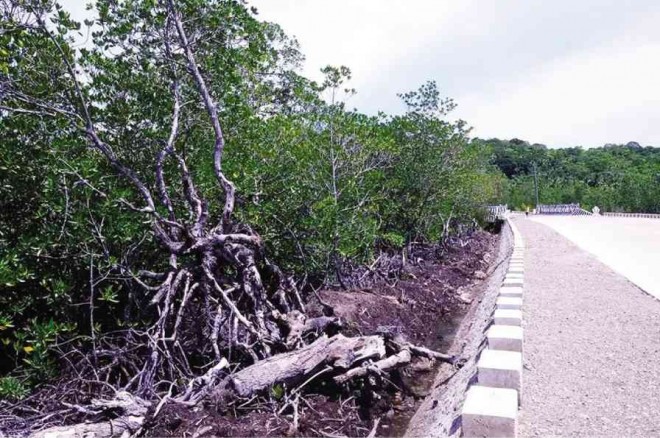Road project promises progress but threatens Sibuyan trees

A 100-KM major road project promises progress in the sleepy island of Sibuyan in Romblon province but an environmentalist group fears this threatens trees and the island’s natural resources. ARIEL RABINO/CONTRIBUTOR
An island, whose folks once stood unified against the threats of mining, is sacrificing a little of its natural resources to open its doors to progress.
At least this is where government officials in Romblon currently stand on the issue of tree-cutting to allow government road projects.
On Sibuyan island, a 100-kilometer circumferential concrete road project by the Department of Public Works and Highways (DPWH) is under way.
Once the project is completed by 2016, the normally four-hour travel time on a private vehicle around the island would be reduced by half.
This, according to Romblon Gov. Eduardo Firmalo, would encourage traders and tourists to go to this naturally abundant but hard to reach haven.
Article continues after this advertisementSibuyan, where people sleep soundly in a deafening silence at night and wake up every day to a view of Mt. Guiting-Guiting’s ridges shrouded in mist, remains a naturally rich but economically poor island.
Article continues after this advertisementIts three towns—Cajidiocan, San Fernando and Magdiwang—are low-income municipalities based on government standards.
But through the years, Sibuyan, also called the “Galapagos of Asia,” has preserved its rich flora and fauna, with species mostly endemic to the Philippines.
An open letter by an island-based environmentalist group, Sibuyan Island Sentinels League for Environment Inc. (Sibuyan ISLE), recently called the attention of Environment Secretary Ramon Paje to a number of mangroves “killed” along a 500-meter stretch in Barangay (village) Cambalo in Cajidiocan.
In the letter dated Aug. 18, Sibuyan ISLE executive director Rodne Galicha said they first noticed that mangroves “were cleared” when he, as member of the Mimaropa (Mindoro, Marinduque, Romblon and Palawan) Regional Development Council representing the private sector, first visited the site in May.
“I understand the predicament of (the) DPWH and the need to address road inundation in the area as the highway crossed a mangrove forest. Be that as it may, all mangrove forests in Sibuyan are protected and in fact an initial component of the National Integrated Protected Areas System (Nipas),” Galicha wrote.
The letter also quoted Presidential Decree No. 705, a basis of the Nipas Act, that named Sibuyan Island an established mangrove forest reserve.
Galicha, in a phone interview, said the matter was first brought to the attention of the DPWH and the Department of Environment and Natural Resources (DENR) in Mimaropa but after failing to receive any response, the group decided to write to Paje.
“It may not be a matter of ‘how massive’ (but this is) about the violation of existing policies,” he said.
A check with the DPWH-Romblon showed that the portion Galicha referred to in the letter was part of the 1.8-km national road that the DPWH widened in Cambalo early this year. This was also a part of the 100-km circumferential road.
“The Sibuyan circumferential project started since (DPWH) Secretary (Rogelio) Singson (took over). We have completed almost half of it now,” said Romblon DPWH district engineer Napoleon Famadico in a phone interview on Wednesday.
The circumferential road receives an annual budget. For 2014, DPWH Romblon received P250 million from the national government.
Aside from the circumferential road, other DPWH projects on Sibuyan were the concreting of the 2.1-km road in Barangay Tampayan in Magdiwang (P35 million), and the concreting of a 2-km rough road in Barangay Mabini in San Fernando (P15 million).
Firmalo said only about 10 to 20 mangroves were cut. “That (number) was very minimal when compared with the progress (the project may bring Sibuyan),” he said.
Famadico insisted no mangroves were killed, saying “only coconut trees were cut.”
He however, could not give the exact number of felled trees. Denying that they violated any state policy, “we do it the proper way and always in coordination with the DENR,” he said.
On Aug. 11, Paje issued a memorandum ordering a freeze on all tree-cutting permits and applications of the DPWH. This was in light of the protests mounted by various advocacy groups against the cutting of trees in areas affected by DPWH’s road-widening projects. Maricar Cinco